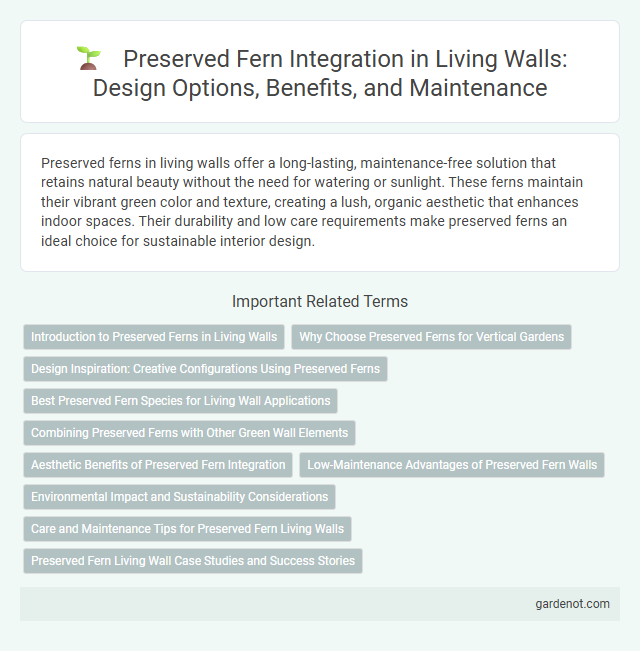Preserved ferns in living walls offer a long-lasting, maintenance-free solution that retains natural beauty without the need for watering or sunlight. These ferns maintain their vibrant green color and texture, creating a lush, organic aesthetic that enhances indoor spaces. Their durability and low care requirements make preserved ferns an ideal choice for sustainable interior design.
Introduction to Preserved Ferns in Living Walls
Preserved ferns are natural ferns treated with a preservation solution to maintain their lush appearance and texture without requiring water or sunlight. These ferns are ideal for living walls, offering long-lasting greenery that enhances indoor air quality and aesthetic appeal with minimal maintenance. Their vibrant green hues and delicate fronds create dynamic vertical gardens that bring nature into interior spaces while reducing environmental impact.
Why Choose Preserved Ferns for Vertical Gardens
Preserved ferns maintain their vibrant green color and natural texture without requiring water or sunlight, making them ideal for low-maintenance vertical gardens. Their ability to retain moisture and flexibility ensures long-lasting beauty and durability in interior and exterior living walls. Choosing preserved ferns enhances air quality while providing an eco-friendly, sustainable option for vertical garden designs.
Design Inspiration: Creative Configurations Using Preserved Ferns
Preserved ferns offer versatile textures and lush greenery, inspiring innovative living wall designs that require minimal maintenance while retaining natural beauty. Creative configurations combine varying fern species and sizes to create dynamic visual patterns and depth, enhancing any interior or exterior space's aesthetic appeal. Incorporating preserved ferns into modular panels or geometric frames allows designers to achieve striking botanical art that remains vibrant year-round.
Best Preserved Fern Species for Living Wall Applications
The best preserved fern species for living wall applications include Boston Fern (Nephrolepis exaltata), Maidenhair Fern (Adiantum), and Staghorn Fern (Platycerium), prized for their lush foliage and durability. These preserved ferns maintain vibrant green hues and natural texture, offering long-lasting aesthetic appeal without requiring regular watering or sunlight. Their natural resistance to decay and ability to thrive in vertical garden installations make them ideal choices for low-maintenance, decorative living walls.
Combining Preserved Ferns with Other Green Wall Elements
Preserved ferns enhance living walls by adding rich texture and vibrant green hues that maintain their freshness without requiring maintenance. Combining preserved ferns with mosses, succulents, and air plants creates a dynamic and multi-dimensional green wall that thrives indoors. These combinations improve air quality and contribute to biophilic design, promoting well-being and aesthetic appeal in interior spaces.
Aesthetic Benefits of Preserved Fern Integration
Preserved ferns enhance living walls by offering lush, natural textures and vibrant green hues that remain consistent without wilting or maintenance. Their long-lasting freshness contributes to a visually appealing vertical garden, promoting a soothing and elegant ambiance in indoor or outdoor spaces. Incorporating preserved ferns supports sustainable decor by reducing water usage and eliminating the need for frequent plant replacement.
Low-Maintenance Advantages of Preserved Fern Walls
Preserved fern walls offer exceptional low-maintenance benefits by requiring no watering, pruning, or sunlight, making them ideal for indoor environments with limited natural light. Their long-lasting freshness and natural appearance provide an evergreen aesthetic without the typical care demands of live plants. These walls reduce the need for frequent replacement and minimize allergy concerns, supporting cleaner and more sustainable interior spaces.
Environmental Impact and Sustainability Considerations
Preserved fern in living walls offers significant environmental benefits by reducing water consumption compared to traditional plants, as it does not require irrigation or soil. Its long-lasting nature diminishes the need for frequent replacements, lowering overall waste and resource use. Utilizing preserved fern supports sustainable interior design through improved air quality and minimized carbon footprint.
Care and Maintenance Tips for Preserved Fern Living Walls
Preserved fern living walls require minimal watering as they retain moisture naturally, making overwatering a common issue to avoid. Maintaining indirect light exposure helps prevent color fading and prolongs the lifespan of the ferns. Regular dusting and occasional gentle misting support the preservation of the lush texture and vibrant appearance of preserved fern living walls.
Preserved Fern Living Wall Case Studies and Success Stories
Preserved fern living walls have demonstrated exceptional longevity and low maintenance in urban office spaces, enhancing indoor air quality and aesthetic appeal. Case studies reveal that preserved ferns retain their vibrant color and texture for up to five years without watering or sunlight, making them ideal for commercial environments. Success stories from corporate headquarters highlight increased employee satisfaction and improved acoustics as direct benefits of integrating preserved fern living walls.
Preserved fern Infographic

 gardenot.com
gardenot.com